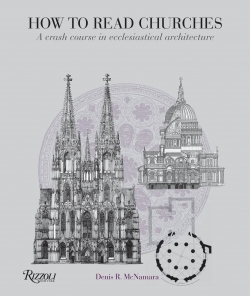How to Read Churches
A Crash Course in Ecclesiastical Architecture
How to Read Churches is a pocket-sized guide for neophytes that’s convenient enough to tote while touring featured buildings ranging from Boston’s Old North Church to Vienna’s St. Stephens Cathedral. In it, Dr. Denis McNamara discusses the structure and purpose of ecclesiastical buildings, enlightening readers about details such as gargoyles: the sad, stone figures on church facades and along the edges of roofs, that are meant to be read as grotesque figures representing those outside the kingdom of heaven; they can also serve as drain spouts for the building, reducing the erosion of mortar.
Author of Heavenly City: The Architectural Traditions of Catholic Chicago, McNamara also reveals the meaning of styles and symbols ensconced in stone, wood, metal, and glass. The book’s 575 color illustrations are from period engravings and line drawings.
“People build churches because they believe in something,” he writes. “Their belief is evident in the styles and material of churches, but also in biblical concepts.” Mosaics, stained glass, and sculptures all represent ideas about heaven and Earth, as do features such as columns, floor plans, and soaring spires. Chapters begin with short introductions, followed by sections with interesting examples. In the chapter “Building Types,” the Synagogue & Temple section notes that the mountaintop Temple of Solomon symbolizes “the indwelling of God among humanity.”
The introduction to “A Grammar of Style” notes how stylistic terms describe various building aspects such as shape, ornament, chronology, and location, and how people of different eras represented theological values. One example is the distinctly styled Russian Orthodox church, with “onion” domes resembling burning candles similar to lighted icons. Other featured styles include Byzantine, in which the cubic shape representing renewed Earth combines with the circular-shaped dome standing in for the “unending movement of God,” and Gothic, said to represent “an ecstatic Classicism composed of columns, arches, and motifs from the antique world combined with a soaring sense of Christian mysticism made possible by advances in engineering.”
Star of the Vaulting & Buttresses chapter, the flying buttress is a free-standing support attached by an arch to transfer thrust. It allows higher walls to encase large windows, and, when framing stained glass, permits the “church interior to become a light-filled and jewel-like image of heaven.” Often carved within buttresses were sculptures of saints, thus the term “pillars of the church.”
Among the more than one hundred churches, abbeys, monasteries, and chapels mentioned are Lichfield, the only medieval cathedral in England with three full spires; the Basilica of Sant’ Apollinare Nuovo in Ravenna, Italy, with its mosaic of moving saints symbolizing joy in heaven; and Westminster Abbey and its ornate bronze gates that lead to a large Lady Chapel, which honors the Virgin Mary.
A reliquary of fascinating facts, How to Read Churches
is also a testament to engineering wonder, and is recommended for anyone interested in architectural history. (Note: the print size may be too small for some readers in their golden years.)
Reviewed by
Alex Moore
Disclosure: This article is not an endorsement, but a review. The publisher of this book provided free copies of the book to have their book reviewed by a professional reviewer. No fee was paid by the publisher for this review. Foreword Reviews only recommends books that we love. Foreword Magazine, Inc. is disclosing this in accordance with the Federal Trade Commission’s 16 CFR, Part 255.

